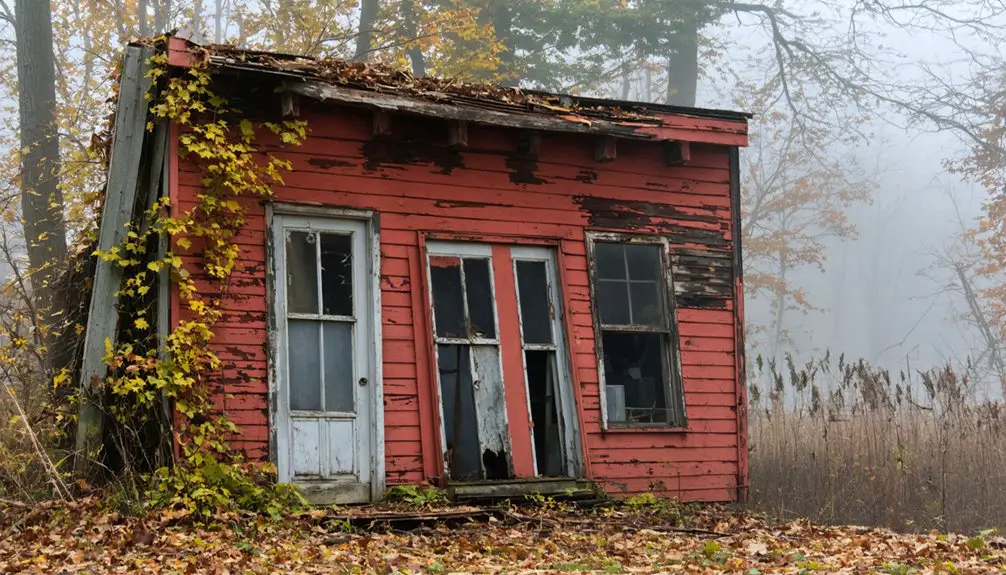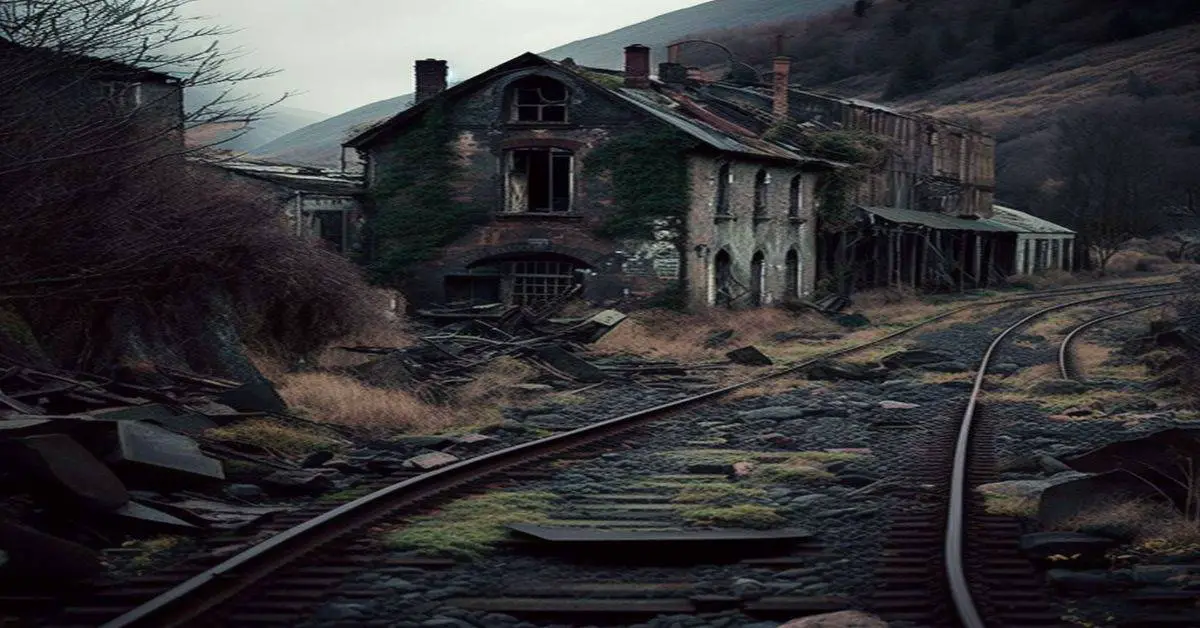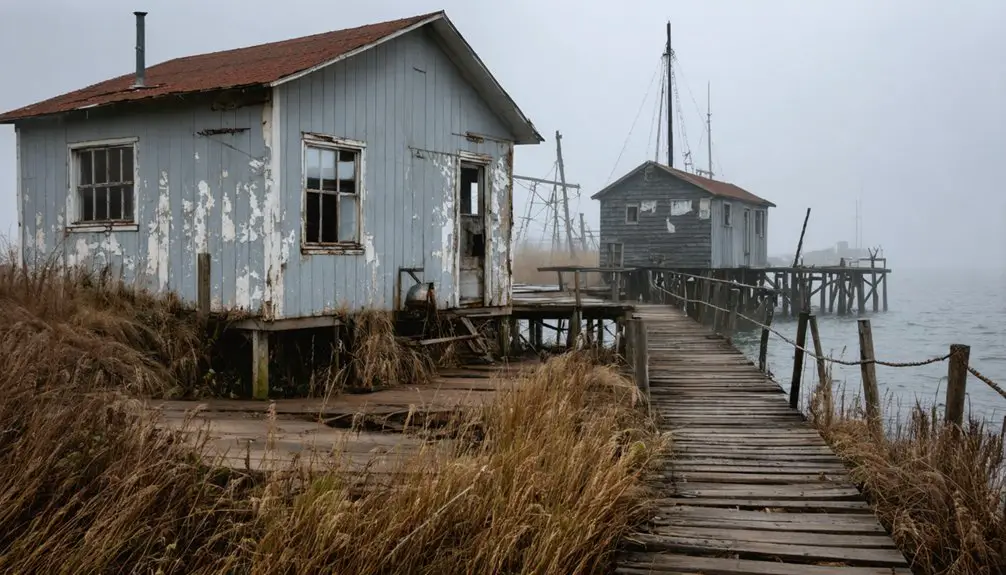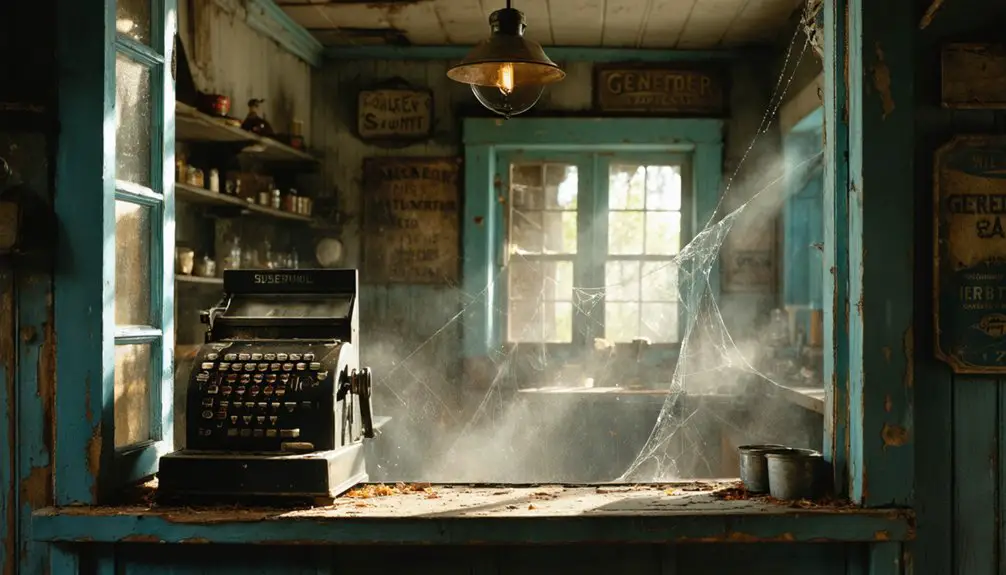You’ll find Helena’s ghost town remnants along the Wisconsin River, where this once-prosperous mining hub flourished in the 1830s. The town’s centerpiece, a revolutionary shot tower built by Daniel Whitney, produced up to 5,000 pounds of lead ammunition daily. Despite its strategic importance during the Black Hawk War and early industrial success, Helena couldn’t survive the railroad era’s economic shifts. Today, Tower Hill State Park preserves the town’s fascinating industrial legacy and mysterious past.
Key Takeaways
- Helena, Wisconsin became a ghost town after multiple relocations, economic decline, and being bypassed by railroads in favor of Spring Green.
- Once a thriving industrial center producing 5,000 pounds of lead shot daily, Helena’s population dropped to about 50 by the 1860s.
- The town’s decline accelerated after the Panic of 1857 and the construction of competing railroad routes through neighboring communities.
- Today, Helena’s historic shot tower is preserved in Tower Hill State Park, serving as a reminder of the town’s industrial past.
- Local legends include bootlegger tunnels beneath the abandoned town and reported paranormal activity in former speakeasies and sealed passageways.
Founding of a Mining Port Town
When Henry Dodge staked out Helena’s location along the Wisconsin River in the early 1800s, he envisioned a strategic port town that would serve the region’s burgeoning lead mining industry.
The founding significance of Helena lay in its proximity to rich lead deposits near Dodgeville, Blue Mounds, and Mineral Point, allowing miners and merchants to transport their valuable cargo efficiently. Like the prosperous Montana city established in 1864, this Wisconsin settlement aimed to capitalize on mineral wealth. Careful attention to place name disambiguation helped distinguish this Helena from other similarly named locations across America.
You’ll find that Helena’s early development was shaped by the crucial mining infrastructure that grew around it.
The town shifted locations three times, but always maintained its critical connection to mining operations and transport routes.
Daniel Whitney’s 1831 shot tower construction near Helena marked a pivotal moment, as the business venture attracted workers and settlers, transforming the river port into a bustling hub of mining commerce.
The Helena Shot Tower Legacy
Daniel Whitney’s ambitious shot tower project transformed Helena from a simple river port into an industrial powerhouse of the Wisconsin Territory.
You’ll find its legacy etched in both the landscape and the region’s development, where a 180-foot engineering marvel combined wooden construction with carved sandstone to produce up to 5,000 pounds of lead shot daily. This industrial innovation revolutionized ammunition manufacturing while establishing crucial trade routes that shaped Wisconsin’s early growth. The surface lead mining near the town provided an abundant and easily accessible source of raw materials.
When you visit Tower Hill State Park today, you’ll see more than just the reconstructed shot tower – you’re witnessing the birthplace of frontier industrialization.
Though the facility’s closure in 1860 led to Helena’s eventual abandonment, its preservation on the National Register of Historic Places guarantees you’ll never forget Wisconsin’s pioneering spirit. The site was later transformed when Unitarian minister Jones purchased the land in 1889 for recreational purposes.
Military Impact During the Black Hawk War
During the Black Hawk War of 1832, Helena’s strategic position along the Wisconsin River made it an essential military outpost for American forces.
General Atkinson led 400 army regulars and thousands of militiamen in search of Black Hawk’s main camp.
You’ll find that military strategies centered around Fort Jackson, which served as a vital distribution hub for weapons and supplies to both militia and regular troops in the region.
The area’s significance grew as Native alliances shaped the conflict’s dynamics. Dakota, Menominee, and Ho-Chunk warriors joined American forces, serving as scouts and guides while patrolling the waterways near Helena.
These combined forces effectively restricted Black Hawk’s band movements, particularly during their retreat toward the Mississippi.
The military presence transformed Helena’s surroundings, as troops requisitioned local supplies and established fortifications that would influence settlement patterns long after the war’s conclusion.
Tribal leaders like Chief Keokuk had chosen to relocate west rather than resist American expansion, creating divisions among the Sauk people.
Relocations and Economic Shifts
As the economic winds shifted in the 1830s, Helena underwent a series of strategic relocations that would ultimately shape its destiny.
You’ll find that each move reflected the town’s desperate attempt to align with changing transportation influences – first relocating northeast to capitalize on Daniel Whitney’s shot tower operations, then altering course again to follow the promising railroad line.
These economic shifts proved challenging for Helena’s residents. Much like Helena, Montana’s pre-territory days were marked by dramatic economic changes that transformed communities.
While the original settlement thrived as a river port serving the lead mining industry, the town’s fortunes began to wane when a bridge was built upstream and the railroad bypassed the area for Spring Green.
Despite relocating closer to the rails, you’d have witnessed Helena’s gradual decline as trade routes changed and the Panic of 1857 dealt a devastating blow to local commerce.
Like many ghost town explorers today, visitors must conduct thorough research to locate Helena’s remaining foundations and ruins.
Railroad Era and Population Decline
You’d find Helena’s fate closely tied to the railroad’s shifting fortunes, as the community initially prospered from its strategic relocation to embrace rail access in 1864.
The town’s development paralleled Wisconsin’s broader mineral-driven economy during this era, as documented in geographical studies of the state.
When rail service began declining after 1916, Helena’s population dwindled rapidly, with many residents moving to nearby towns that maintained better transportation connections.
The shot manufacturing industry had once provided a strong economic foundation for the town as Wisconsin’s sole producer of lead shot.
The rise of automobile transport and the gradual reduction in Wisconsin’s rail networks dealt the final blow to Helena’s viability as a commercial hub, leading to its eventual abandonment.
Rail Line Bypass Impact
When the Chicago & North Western Railway constructed its Milwaukee-to-Wyeville bypass in 1911, Helena’s fate as a rail hub began to decline. The new route avoided steep grades and tunnels, making it more efficient for trains heading to the Twin Cities and Dakotas.
You’ll find that this bypass dealt Helena a crushing blow – rail service dwindled as trains opted for the shorter, easier route.
The town’s economic isolation intensified as freight and passenger traffic diminished. Local businesses that once thrived on rail commerce, including shot manufacturing and lumber operations, struggled to maintain profitability.
Without regular train service, Helena’s residents faced mounting challenges in shipping goods and traveling. Many families eventually left town, seeking opportunities in communities along the new rail corridor, contributing to Helena’s transformation into a ghost town.
Population Exodus Factors
Multiple crises converged to drive Helena’s population exodus well before the 1911 railroad bypass.
You’d have seen the first major blow during the Panic of 1857, when economic instability devastated local industries and forced many residents to seek work elsewhere. The Black Hawk War of 1832 had already disrupted the community when inhabitants joined militias, and the military’s requisition of local buildings further damaged the town’s infrastructure.
Transportation changes dealt another serious setback, as a new bridge upstream diverted river trade away from Helena.
When the town relocated four miles northeast to chase rail connections, many residents simply didn’t follow. By the 1860s, you’d have found only about 50 people remaining, as depleted resources and shifting trade routes had stripped Helena of its economic significance.
Nearby Towns Take Over
The construction of the railroad through Spring Green in the late 19th century marked Helena’s final descent into obscurity.
You’ll find that Spring Green and other rail-connected towns quickly absorbed Helena’s former commercial roles, creating fierce trade competition that the riverside settlement couldn’t overcome. The railway’s superior speed and reliability gave these towns an insurmountable advantage in shipping lead, lumber, and other goods.
The economic migration that followed was swift and decisive. You can trace how merchants and residents abandoned Helena’s original location, moving northeast to stay viable.
Despite their efforts to relocate closer to the rails, Helena’s population dwindled to about 50 people by the mid-1860s. The rail towns’ dominance was complete, permanently shifting the region’s economic center away from the once-thriving river port.
Paranormal Tales and Local Legends
If you’re walking Helena’s historic streets after dark, you’ll encounter tales of phantom birds from the old Stonehouse and unexplained footsteps echoing through Reeder’s Alley, where miners and bootleggers once dwelled.
The town’s gold mining heritage has left its spiritual mark, with visitors reporting ghostly encounters near abandoned mine shafts and former brothels.
Local legend speaks of bootleggers’ hidden tunnels beneath the town, where spirits of smugglers are said to still guard their illicit cargo.
Ghost Stories After Dark
Lurking within Helena’s historic Reeder’s Alley, unseen presences have captivated locals and visitors since the gold mining era of the 1800s.
You’ll encounter ghostly encounters that defy explanation, from spectral whispers in the Stonehouse to mysterious footsteps echoing through darkened corridors.
As night falls, you’ll discover why Helena’s earned its reputation as Wisconsin’s most haunted mining town:
- Phantom bird songs pierce the silence of the Stonehouse restaurant, reminiscent of canaries once kept by former residents.
- Spiritualists, bootleggers, and sex workers from the past make their presence known through unexplained phenomena.
- The historic Stonehouse building reveals its dark Prohibition-era secrets through paranormal activity.
- Tour guides share tales of misfortune and hardship while leading you through Helena’s most active haunted locations.
Mining Spirits Still Linger
Deep within Helena’s abandoned lead mining structures and forgotten river ports, spirits of 19th-century miners and workers still make their presence known.
You’ll hear tales of phantom footsteps echoing through the shot tower Daniel Whitney built in 1831, where mining folklore suggests restless souls from the lead trade continue their eternal work.
As you explore the layers of buried foundations from Helena’s multiple relocations, you might encounter ghostly encounters tied to the town’s mining heritage.
The spirits of lead miners who braved dangerous conditions, along with river workers who once loaded mineral cargo onto waiting vessels, are said to linger in these historic grounds.
Local legends tell of unexplained noises in old warehouse sites and mysterious figures appearing near former mining supply buildings.
Bootleggers’ Secret Underground Passages
Beneath Helena’s historic streets lies a complex network of bootlegger tunnels, remnants of Wisconsin’s turbulent Prohibition era.
You’ll find these underground passages connecting former speakeasies and hidden storage rooms, where bootleggers once moved their illicit cargo under cover of darkness.
Local legends tell of paranormal activity in these abandoned corridors, where you might encounter:
- Mysterious footsteps echoing through sealed passageways
- Shadowy figures darting around corners, believed to be spirits of gangsters
- Unexplained cold spots near former escape hatches
- Phantom sounds of bottles clinking and hushed voices
These underground passages, some leading to the nearby river, mirror similar networks found throughout Wisconsin’s small towns.
While most entrances are now sealed, stories persist of undiscovered caches of moonshine and gang money still hidden within these silent corridors.
Historic Landmarks and Preservation
While little remains of Helena’s original settlement, Tower Hill State Park now preserves the town’s most significant industrial landmark – the Helena Shot Tower.
Built in the early 1830s by Daniel Whitney’s company, this historic preservation site showcases Wisconsin’s industrial heritage through restored exhibits demonstrating 19th-century lead shot production.
You’ll find the tower’s original lead-melting bowl atop the cliff, where workers once transformed raw materials into ammunition.
Though many of Helena’s buildings were demolished during the Black Hawk War of 1832 to construct military rafts, the shot tower’s legacy endures.
The town itself existed in three different locations along the Wisconsin River before its ultimate decline, prompted by the Civil War, economic downturn, and the railroad’s decision to bypass Helena for Spring Green.
Notable Characters and Events
Several key figures shaped Helena’s early development, beginning with Henry Dodge’s establishment of the original river port settlement in 1830.
You’ll find their legacies woven into the town’s rich mining history and cultural fabric.
Key early settlers who influenced Helena’s growth:
- Daniel Whitney launched the innovative Helena Shot Tower, revolutionizing local lead processing.
- Craven Lee claimed land along North Fork Trinity River in 1852, founding the original “North Fork” settlement.
- German immigrant Harmon Schlomer constructed many of the town’s essential buildings after 1855.
- John and Helena Meckel’s presence led to the town’s renaming in 1891.
During the Black Hawk War of 1832, Helena’s buildings were sacrificed to construct rafts for U.S. troops, marking a pivotal moment in the settlement’s military significance.
Helena’s Role in Wisconsin Territory
A strategic outpost in the Wisconsin Territory, Helena emerged as an essential river port linking the lead mining regions of Dodgeville, Mineral Point, and Blue Mounds to broader trade networks.
You’ll find Helena’s significance deeply woven into the territorial economy, particularly through Daniel Whitney’s shot tower operations that transformed raw lead ore into manufactured goods.
During the Black Hawk War, Helena’s location proved vital for military logistics, as U.S. troops under Henry Atkinson ferried 1,300 men across the Wisconsin River.
The settlement’s buildings were even sacrificed to create rafts for pursuing Black Hawk’s forces.
While Helena’s prosperity peaked in the mid-1850s, you can trace its eventual decline to shifting transportation patterns, particularly when the railroad bypassed the town in favor of Spring Green.
Frequently Asked Questions
What Was the Average Temperature and Climate in Helena During Its Peak?
Hold your horses – you’d experience average climate patterns with temperature trends ranging from bitter winters below 20°F to warm, humid summers reaching 85°F, plus 30-35 inches of yearly precipitation.
How Did Families Educate Their Children in Helena’s Early Settlement Days?
You’d find your children learning through a mix of homeschooling practices and community schooling, with teachers boarding at local homes and walking miles to reach small log schoolhouses serving immigrant families.
What Types of Food and Agriculture Were Common in Helena?
Picture your grandfather clearing stubborn stumps to plant hardy crops like corn, oats, and potatoes. You’d raise livestock and sell extra produce at local markets to sustain your family’s independence.
Did Helena Have Any Churches or Religious Organizations During Its Existence?
You won’t find records of formal churches in this settlement, though religious diversity likely existed through informal community gatherings. Historical documents don’t confirm any established religious organizations during its active period.
What Diseases or Medical Challenges Did Helena’s Residents Commonly Face?
Though you’d hope medicine had advanced, you’d face deadly tuberculosis outbreaks, cholera, typhoid fever, and lead poisoning from shot manufacturing, plus common ailments made worse by limited medical care.
References
- https://en.wikipedia.org/wiki/Helena
- https://usghostadventures.com/helena-ghost-tour/
- http://freepages.rootsweb.com/~gtusa/history/usa/wi.htm
- https://raregoldnuggets.com/?p=3963
- https://lakecountrytribune.com/exploring-the-haunting-echoes-of-wisconsins-ghost-towns/
- https://westernmininghistory.com/towns/montana/helena/
- https://www.wisconsinhistory.org/Records/Article/CS410
- https://dnr.wisconsin.gov/topic/parks/towerhill/history
- https://www.wisconsinhistory.org/Records/Article/CS408
- https://en.wikipedia.org/wiki/Tower_Hill_State_Park



